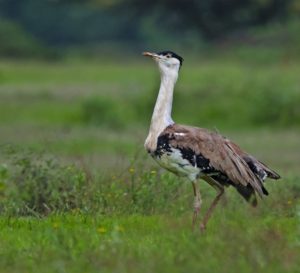Published on: December 15, 2021
GREAT INDIAN BUSTARD
GREAT INDIAN BUSTARD
NEWS
The Centre has approached the Supreme Court seeking modification of its order directing that all transmission cables in the habitat of the Great Indian Bustard (GIB) be laid underground
REASON CITED
- Area falling in Rajasthan and Gujarat contains a large proportion of the country’s total solar and wind energy potential and the process will escalate the cost of renewable energy production and hurt India’s renewable energy cause
- Energy transition is essential for reducing emission and controlling climate change and India has made international commitments including under the agreement signed in Paris in 2015 under the United Nations Framework Convention on Climate Change (UNFCCC)
WHAT WAS SC ORDER
In a bid to check the dwindling numbers of the endangered Great Indian Bustard and Lesser Florican, a Supreme Court bench had directed that overhead power lines be laid underground, wherever feasible, passing along the habitat of the birds in Rajasthan and Gujarat.
ABOUT GIB
- Considered among the largest flying birds in the world
- State bird of Rajasthan

- India’s most critically endangered bird.
- Flagship grassland species, representing the health of the grassland ecology.
- Population is confined mostly to Rajasthan and Gujarat. Small populations occur in Maharashtra, Karnataka and Andhra Pradesh.
- Under constant threats due to collision/electrocution with power transmission lines, hunting (still prevalent in Pakistan), habitat loss and alteration as a result of widespread agricultural expansion, etc.
- Reasons for decline in Population:
- Loss of Habitat due to increase in population, agriculture and infrastructure development etc.
- GIBs are large in size and usually take low flights which often result in deaths due to collision with electricity transmission lines.
- Stray dogs which are known to attack the bustard’s eggs and young ones.
- Poaching outside the protected areas.
- Protected areas dedicated to GIB
- Rajasthan: Desert National Park – Jaisalmer and Balmer
- Gujarat: Naliya Sanctuary in Kutch
- Madhya Pradesh: Karera Wildlife Sanctuary (The species disappeared from Madhya Pradesh in early 90s’)
- Maharashtra: Nannaj Grasslands, Solapur
- Andhra Pradesh: Rollapadu Wildlife Sanctuary
- Conservation Status
- Listed under Critically Endangered Category of IUCN Red List.
- Listed in Schedule I of the Indian Wildlife (Protection) Act, 1972. It is also listed in Appendix I of CITES.
- Identified for the species recovery program under Integrated Development of Wildlife Habitats Scheme.

